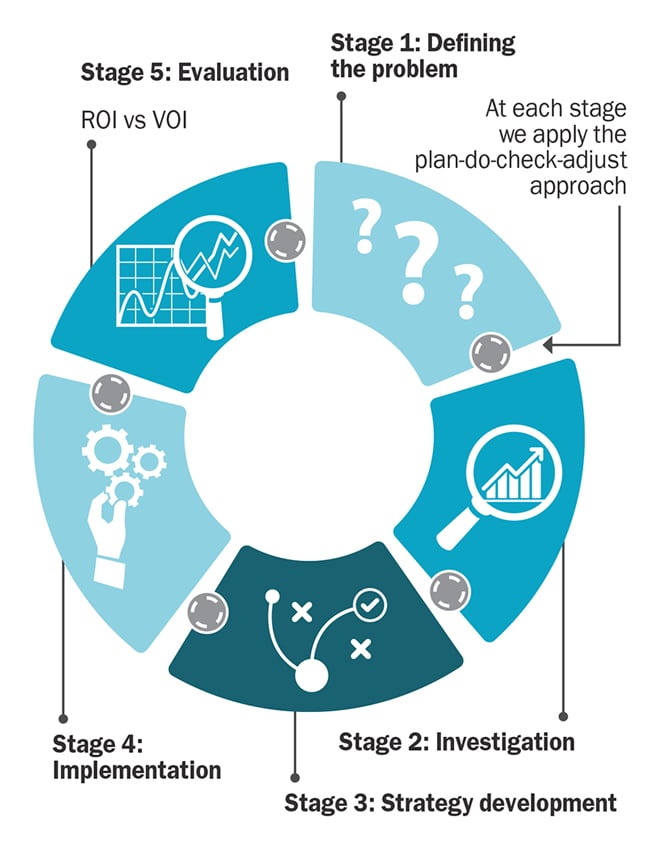Taking an evidence-based approach to link health, engagement and productivity

ARE you confident your organization’s programs, policies and procedures will net at least a three per cent improvement in employees’ health, engagement and productivity over the next 12 months?
Now, imagine if your CEO or a board member or senior leader asked you the above question today — how comfortable would you be in giving an answer?
Current trends suggest a growing percentage of the workforce is being negatively impacted by harassment, mental health issues, work demands, job insecurity, turnover, financial stress and industry change due to technology. Employers are challenged to not only retain employees but have them show up each day motivated and capable of doing their best.
The one profession best equipped to work with occupational health and safety (OHS) to support human capital — and to put in place the structure that can answer questions like the above — is human resources.
For any HR professional to answer with a high degree of confidence they would, at a minimum, need the following:
- Understanding and acceptance of the direct link between employees’ health (meaning mental health, resiliency and psychological safety), engagement and productivity.
- Confidence in the value of making investments to influence employees’ health, engagement and productivity.
- Awareness of the specific benefits and impact a three per cent improvement could have on an organization’s financials.
- Commitment to continuous improvement, using an evidence-based strategy that informs, monitors and measures programs, policies and procedures’ impact on employees’ health, engagement and productivity.
This is the first in a 12-part series on total health that will explore what we have learnt about the links between employees’ health, engagement and productivity. With a total health framework, organizations can get on track to answer these types of questions with a high degree of confidence.
The total health framework
The total health framework has adapted best practices from Canada’s Psychological Health and Safety in the Workplace standard, which provides principles and tools employers can use to facilitate an evidence-based continuous improvement program. Its goal is to eliminate employees’ risk for mental injuries and prevent work-related mental health issues.
The standard’s design is similar to a traditional occupational health and safety management system. But it’s not meant to be a checklist or a one-and-done initiative — it’s meant to be an ongoing program that facilitates continuous plan-do-check-adjust (PDCA) cycles. When fully implemented, the standard provides a psychological health and safety management system that regularly checks for risks by ongoing measurements, internal audits and management reviews.
The total health framework is holistic in nature, as it contemplates four pillars of health: physical, mental, workplace and life (financial, relationships and work-life blending) with respect to how each can impact employees’ health, engagement and productivity.
Its design is similar to the standard in that it’s evidence-based, with the goal of facilitating continuous improvement using PDCA cycles. This framework is dynamic — an organization can start at any step in the process, as laid out in the accompanying graphic. It’s designed to be flexible to support implementing a psychological health and safety management system for solving a specific problem.
The framework’s five steps:
- Define the problem — The goal is to uncover current challenges and why these are of concern. This step can include a gap analysis to understand root cause, define organizational readiness and maturity, understand leadership buy-in, and gain insights on available data. It can also build a business case that unpacks the cost of doing nothing.
- Investigate — This step’s goal is to obtain a baseline of workplace factors (such as bullying, manager-employee relationships and workload) that can positively or negatively impact employees’ health, engagement and productivity. It also discovers the average employee’s total health behavioural profile across each of the four pillars, using a total health assessment called Total Health Index.
- Develop strategy — This step reviews all available evidence-based data that supports problem-solving and informed decision-making. This framework promotes a two-way accountability model to achieve behavioural change, by defining key objectives and metrics. Once these are framed, it’s necessary to contemplate how to best engage employees and to communicate the model’s benefits, as well as how to implement new policies, procedures and programs.
- Design programs — This step is where programs are designed, implemented and measured. This process considers cultural factors, targeted populations, adult learning methodology, program evaluation and ROI targets. It also seeks to understand why employees engage, and why programs work or fail.
- Determine value of investment (VOI) — This step measures the impact of programs, procedures and policies on employee health, engagement and productivity. Depending on the total health strategy, it may include internal audits, total health scorecards review, management reviews and VOI reports.
The total health five-step framework can help organizations resist the urge to automatically go from problem to programs. It enables them to put in place an evidence-based framework that promotes sustainability and continuous improvement.
Organizations looking to adopt best practices from the standard and implement a psychological health and safety management system can build on the total health framework.
When it comes to retaining a highly engaged and healthy workforce, the benefits and risks can be high. It’s much more effective to use an evidence-based approach versus a hope-and-pray method.
When implemented, the total health framework gives HR professionals the confidence that they are on track to reach targeted outcomes (such as a three per cent improvement) in the coming year.
To learn more on the total health framework, please go to www.morneaushepell.com.
Bill Howatt, Ph.D. Ed.D., is the chief of research and development, workforce productivity, at Morneau Shepell in Toronto. For information on the national psychological standard, visit www.csagroup.org. For information on PDCA cycles, see www.deming.org.
12-PART SERIES
This is the first of a 12- part series on total health that will explore the links between employees’ health, engagement and productivity:
- The total health framework
- Four pillars of the total health index
- Canada’s total health index
- Resiliency
- Alcohol
- A respectful workplace
- Manager effectiveness
- Financial health
- Going beyond traditional engagement
- Productivity
- Mental health
- Physical activity, nutrition, sleep





